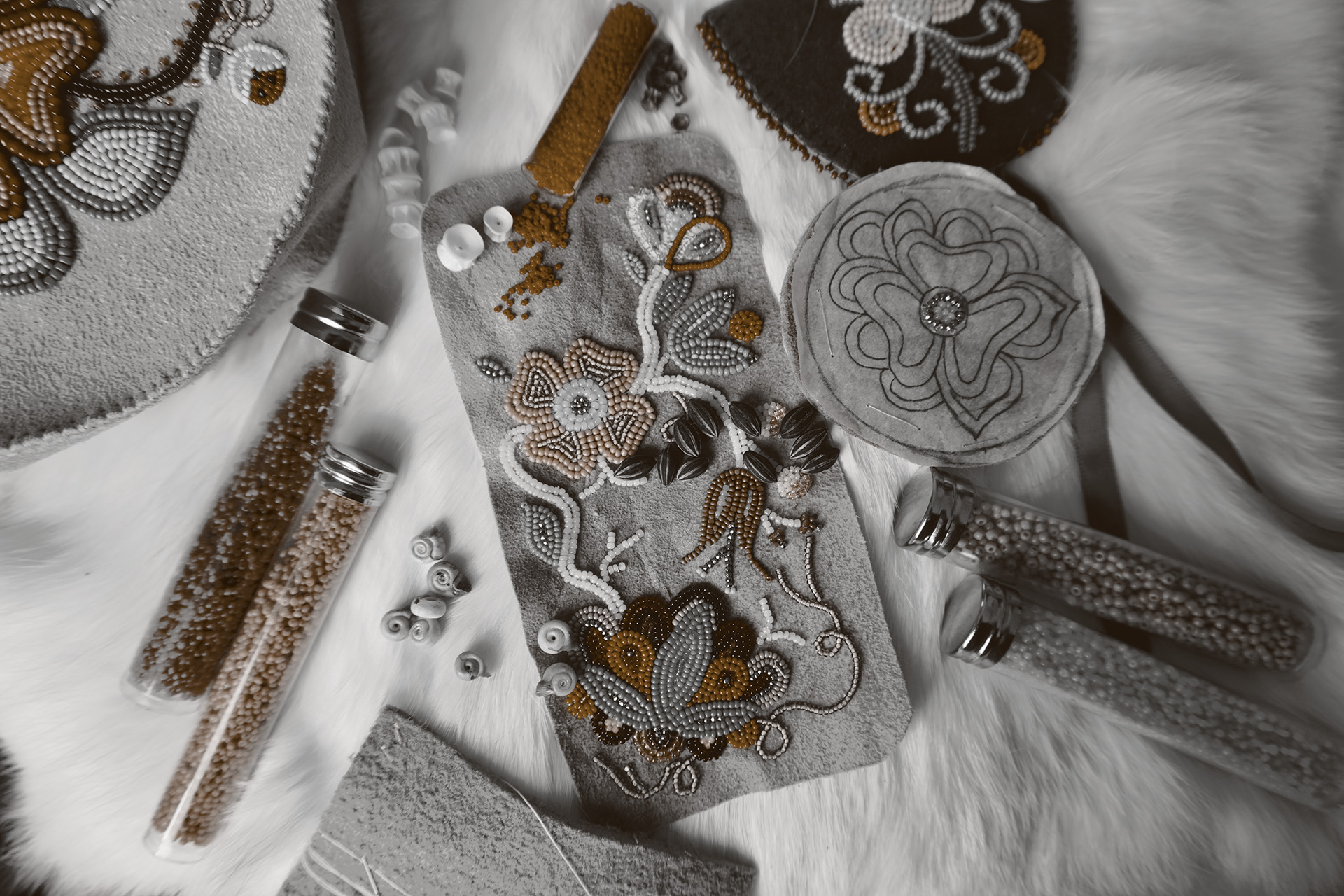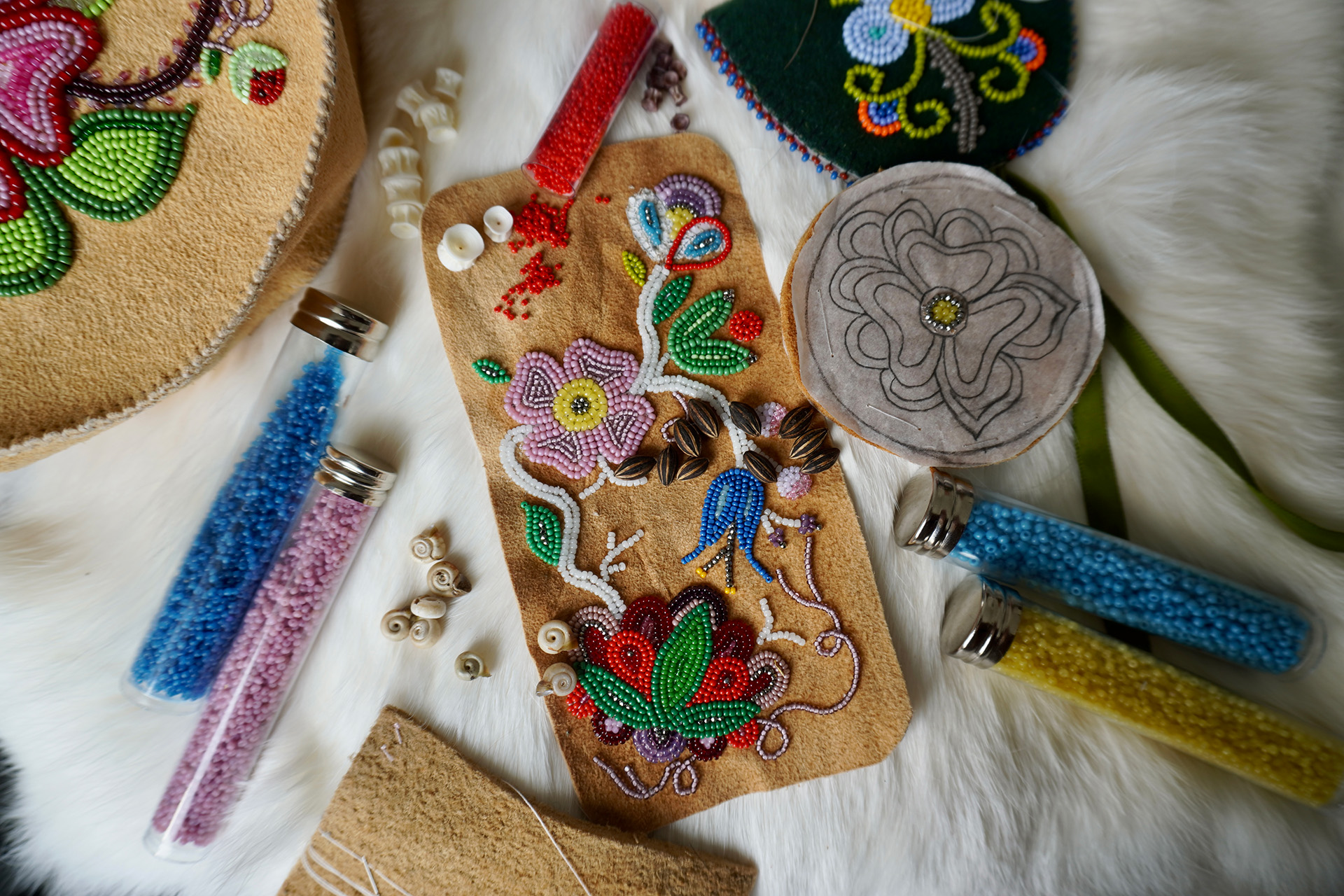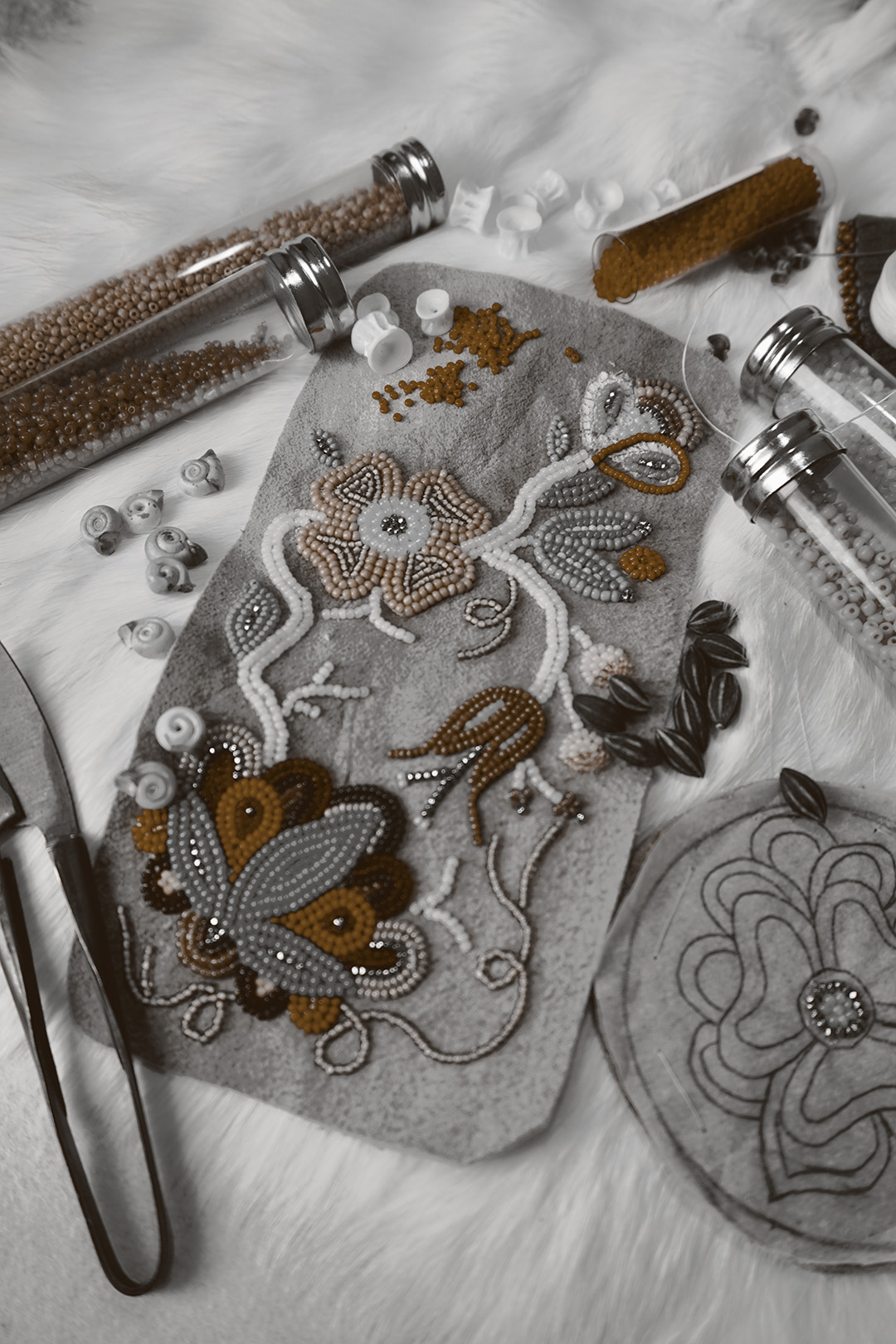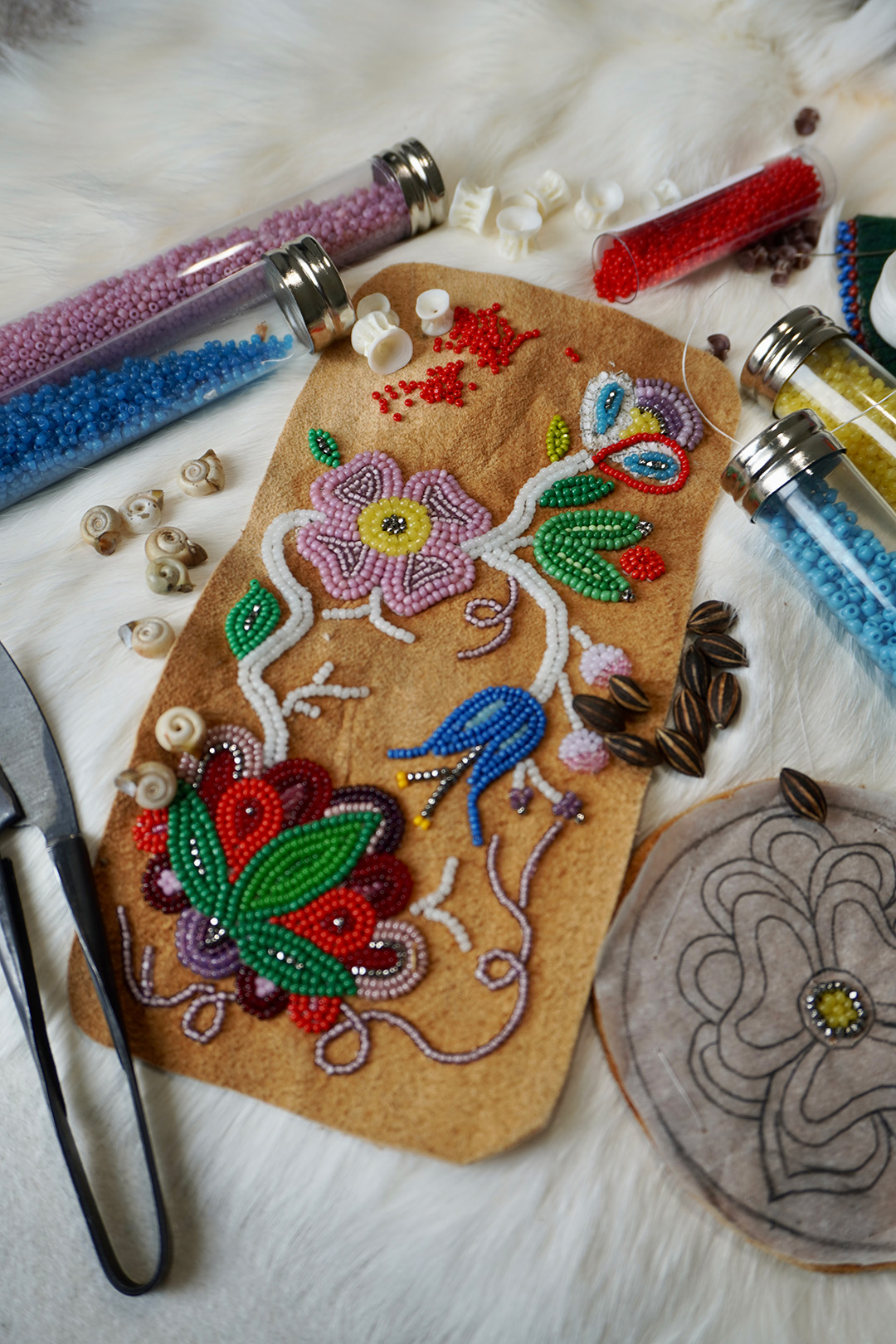Seed Bead Inheritances & Other Toxicities
Kristen Bos

White rabbit fur; smoked deer hide bag; Métis floral beadwork consisting of pre-1920s vintage Venetian and Parisian beads, 1920s French steel cut beads, and contemporary charlotte cut beads from India, on a piece of smoked deer hide that will become an iPhone case; beaded needle case by the artist and designed by their mentor and Master Beadworker Jennine Krauchi; beaded pin template on smoked moose hide that the artist is beading for Métis Elder and Matriarch Maria Campbell; four vials of pre-1920s French vintage seed beads; Wolf willow seed beads harvested by the artist in downtown Winnipeg; Snail shells the artist collected on the shores of Greenwater Lake in Treaty 3 Territory; Lake trout vertebrae beads from a trout caught by the artist in Treaty 3 Territory at Sherwood Lake where their dad lives; Manitoba choke-cherry dyed pickerel vertebrae beads handmade by the artist; thread cutters. Courtesy of Claire Johnston.


Years before I would turn to seed beads and beading as a research subject and co-conspirator, I learned, while beading with an Elder in a beading circle at the Native Women’s Resource Centre of Toronto, that we did not just get seed beads from colonizers as is commonly thought. She shared that glass seed beads could be found long before the colonizers arrived, shimmering in the waves and washing up on the shores at water’s edge. I believed her. After all, beading circles are spaces for grandmothers to share their knowledge, in person or in the beadwork themselves, across time and space as we have always done.Leanne Betasamsoake Simpson, As We Have Always Done: Indigenous Freedom through Radical Resistance (Minneapolis: University of Minnesota Press, 2017). Evoking a time wherein “the rivers acted as our Internet—though undoubtedly at dial-up speed—and beadwork served as a guide for the territories we navigated, a map for our bloodlines, a coded knowledge for prayers and good thoughts embedded in the clothing of our loved ones.”Adrienne Huard, “Beads They’re Sewn So Tight,” Public 30, no. 60 (2020): 278–281. Stoking time after time wherein resistance must be centered and balanced like in a good floral.
I have been changed before in this and in other spaces, that is, “if the thread doesn’t tangle and the needles don’t break”—though broken needles tell us something too.Sherry Farrell Racette, “If the Thread Doesn’t Tangle and the Needles Don’t Break: Beading Utopia” (paper, Manidoominensagemin Toronto [we are beading in Toronto], Textile Museum of Canada, Toronto, January 25, 2019). I don’t need to reference the written records or even the genetic analyses that support “pre-colonial” and “pre-historic” relations between Indigenous peoples and others—other peoples, other lifeforms, other kin—to understand that it is possible to find glass seed beads at the meetings of the water. These exchanges continue, with and without our consent.
I think of our conversation as I doomscroll through the headlines—
“Microplastics from European rivers spreading to Arctic seas, research shows,” says The Guardian.
“Microplastics have moved into virtually every crevice on Earth,” says National Geographic.
“Microplastics found in human blood for first time,” says The Guardian, again.
Since time immemorial, pierced materials such as shells, turquoise, native copper, and meteoric iron have circulated between Indigenous relations. Following colonization, our beads took on new materials and relations in the form of glass. Though in English, these were known as glass seed beads, they were often “given the older names” of either mekis (shells) or manidoo minens or mines (spirit seeds).Sherry Farrell Racette, “My Grandmothers Loved to Trade: The Indigenization of European Trade Goods in Historic and Contemporary Canada,” Journal of Museum Ethnography 20 (2008): 71. I learn later from Jennifer Meness that the spirits of the seed beads are in their capacities for bringing us together and in how, in their loose forms, they offer us infinite possibilities. In Michif, it’s pèrl (pearl) or dé mémoyr dno zansèt (stories of our ancestors).
I wonder how much of microplastics count as microbeads. Microbeads, or “Ugelstad particles,” named after the Norwegian chemist who invented and then patented his method of producing uniform polymer particulars in the late 1970s, are used as exfoliating agents in products like toothpaste, soap, and face wash. Microbeads replaced other materials like pumice, oatmeal, and walnut husks. As far as I know, they have not been given any older names. Though I think something like oochaywaahtamwuk (swarm), ka pakwatutt (enemy), or ahkosôwin (disease) might work.
I think of our conversation whenever I remember that microplastics refuse to dissolve and, so, they are found everywhere, especially shimmering in the waves and washing up on the shores at water’s edge.
Leanne Betasamsoake Simpson, As We Have Always Done: Indigenous Freedom through Radical Resistance (Minneapolis: University of Minnesota Press, 2017).
Adrienne Huard, “Beads They’re Sewn So Tight,” Public 30, no. 60 (2020): 278–281.
Sherry Farrell Racette, “If the Thread Doesn’t Tangle and the Needles Don’t Break: Beading Utopia” (paper, Manidoominensagemin Toronto [we are beading in Toronto], Textile Museum of Canada, Toronto, January 25, 2019).
Sherry Farrell Racette, “My Grandmothers Loved to Trade: The Indigenization of European Trade Goods in Historic and Contemporary Canada,” Journal of Museum Ethnography 20 (2008): 71.

